Your message has been sent.
We’ll process your request and contact you back as soon as possible.
The form has been successfully submitted.
Please find further information in your mailbox.
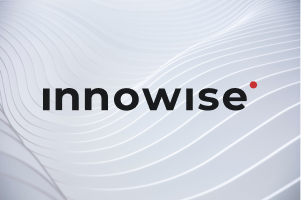
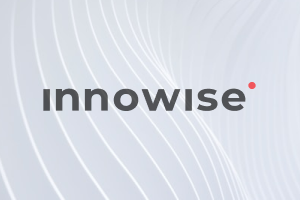
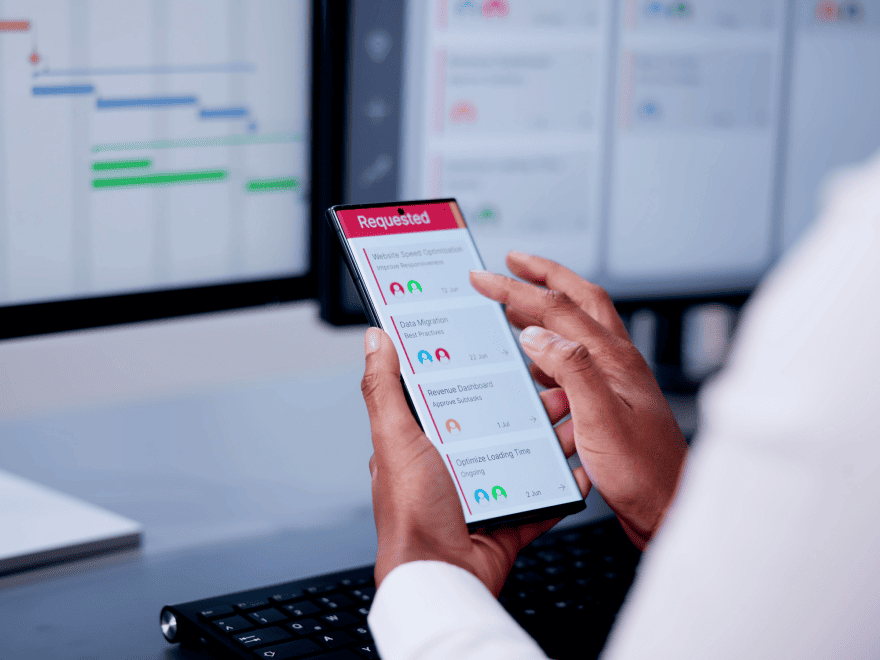
Choosing the best software development methodology isn’t just a technical decision. It’s a strategic one. I’ve watched great ideas crash not because of bad execution, but because the process didn’t match the project. On the flip side, some of the most unexpectedly successful projects weren’t flashy — they just had the right approach from the start.
So if you’re wondering whether to go Agile, Waterfall, DevOps — or something in between — this article is for you. Whether you’re building in-house or partnering with a team for custom software development services, understanding the pros and cons of different methodologies can make or break your success.
Let’s walk through the most common software development methodologies, their strengths, trade-offs, and how to make the right call for your next project. And no fluff — I’ll share my own hard-earned lessons along the way.
Let’s get one thing straight: your choice of software development methodology will either accelerate your success or quietly sabotage it. I’ve worked with companies that had the tech, the talent, and the funding — but still stumbled. Why? Because they were sprinting with Waterfall when they should’ve been iterating with Agile. Or they clung to legacy software development methods when the market demanded speed and adaptability.
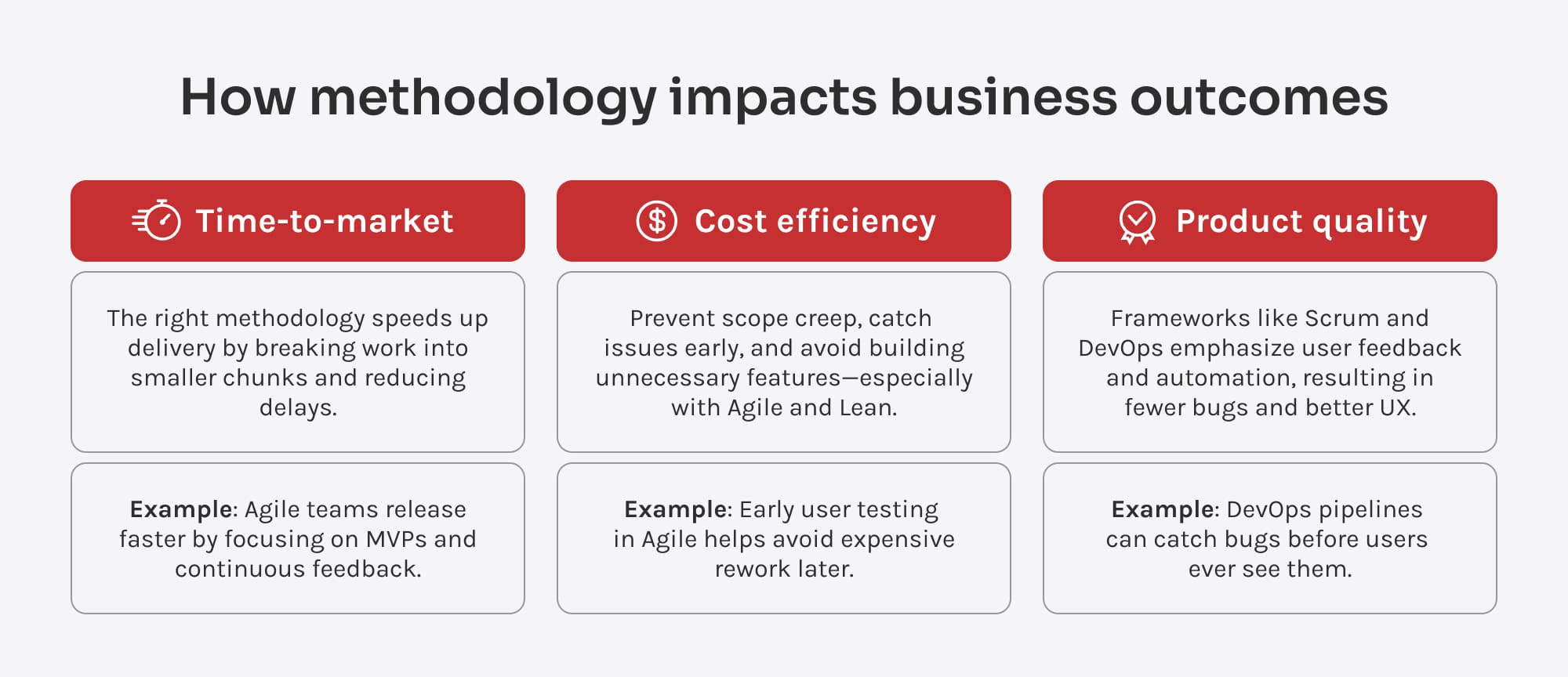
In today’s economy, getting your product to users fast is often more important than getting it perfect on the first try. That’s where Agile, and particularly Scrum, shine. Teams that embrace this approach often get to market sooner, not by working more hours, but by working smarter. Instead of waiting for a massive launch, they deliver in manageable increments, learn from real-world feedback, and adjust as they go.
Sometimes teams using Agile methodologies cut their go-to-market time in half — not because they worked harder, but because they worked smarter, releasing in increments instead of chasing an all-or-nothing launch.
On the other hand, Waterfall still has its place, especially in heavily regulated industries like healthcare or aerospace, where each phase must be documented and signed off. The trade-off? Longer timelines. And if market conditions shift mid-project, tough luck. You’re locked in.
Now, let’s talk budget. Businesses love the idea of fixed-cost projects, and Waterfall often promises just that. But here’s the rub: what you gain in predictability, you often lose in flexibility. If a requirement changes (and it will), adapting late in the cycle can cause massive rework and massive expense.
Agile, meanwhile, can feel a bit scarier to stakeholders who want exact costs upfront. But from experience, it usually leads to lower overall costs. Why? Because problems are caught early, user feedback is integrated continuously, and teams avoid building features that no one ends up using.
A beautiful, feature-rich product is worthless if no one wants to use it. This is where different software development methodologies like Scrum and practices like DevOps prove their worth.
Scrum encourages constant iteration and user feedback, meaning teams aren’t just building software — they’re solving problems. And DevOps? It adds another layer of quality by integrating automated testing and continuous deployment. The result is fewer bugs in production and faster recovery when something does go wrong.
I once consulted on a DevOps-driven e-commerce project where deployment frequency jumped from once every two weeks to 10 times per day! Not only did it improve user experience, but it also boosted conversions because the team could roll out improvements in real time based on A/B testing data.
Bottom line? The right software methodology doesn’t just shape how you build — it shapes what you build, how fast you can deliver, and how much value your users actually get. If you’re not aligning your process with your business goals, you’re not just wasting time — you’re leaving opportunity on the table.
We’ll help you build it the smart way: with the right team and the right approach.
If there’s one thing I’ve learned after years of leading and advising software projects, it’s this: the real problem isn’t choosing the wrong methodology — it’s thinking you’ve chosen one, when you haven’t chosen anything at all.
A lot of development and operations teams say they’re doing “Agile,” but Agile is just a mindset. It’s a set of values and principles outlined in the Agile Manifesto, not a ready-to-go framework. To actually do Agile, you need to implement a software engineering methodology that brings those principles to life, like Scrum, Kanban, or XP.
So let’s see a list of software development methodologies and talk specifics.
Scrum is all about working in short, structured sprints, with clear goals and regular feedback loops. It gives teams focus and rhythm, and it works wonders for products that need to evolve quickly based on user input. It turns chaotic roadmaps into shipping machines — when done right.
Kanban is a visual workflow system that helps teams manage continuous tasks. Think of it like a dynamic to-do board with rules. It’s great when work is less about “sprints” and more about flow — like bug fixing, ops, or support teams.
XP emphasizes technical rigor and collaboration — short cycles, pair programming, automated tests, and constant refactoring. It’s intense but incredibly effective for high-risk environments where quality is king. Not every team is ready for it, but when they are, the results are rock solid.
Waterfall follows a linear, phase-by-phase software development process. You gather requirements, then design, build, test, and release — one step at a time. It’s not trendy, but for projects with tight regulations or heavy documentation needs, it still holds its ground.
Lean is about eliminating waste and maximizing value. While it shares DNA with Agile, Lean has its own practices and tools and is often used at scale to guide process efficiency across departments — not just development. It’s especially useful when aligning IT with broader business transformation goals.
DevOps isn’t a type of software development methodology — it’s more like a cultural and operational overlay. It’s what happens when development and operations stop working in silos and start building, testing, and deploying software together, continuously. DevOps is often used in tandem with Agile frameworks like Scrum or Kanban.
Let’s be honest — most real-world teams end up blending software development approaches. Maybe it’s Scrum with Kanban-style boards, XP development practices, and DevOps pipelines. That’s not a bad thing — if you know what you’re doing and aren’t just duct-taping software design methods together.
Here’s a cleaner side-by-side view to help you compare:
| Methodology | Strengths | Watch outs | Best for |
| Scrum | Quick delivery, adaptability, team ownership. | Requires experienced team and product owner; can feel chaotic if misapplied. | Fast-changing, user-focused projects with cross-functional teams. |
| Kanban | Continuous delivery, simple to adopt, visual clarity. | No timeboxes; pace may be harder to predict. | Ongoing support, maintenance, or ops-heavy environments. |
| XP | Exceptional quality, robust testing, close collaboration. | Demands a high level of discipline and pairing. | High-stakes development where code quality is critical. |
| Waterfall | Predictable, well-documented, easy to plan. | Inflexible; poor fit for changing requirements. | Regulated industries or projects with fixed requirements. |
| Lean | Efficient, value-driven, scalable. | Risk of being misinterpreted as just “cutting costs.” | Enterprise-scale or long-term optimization initiatives. |
| DevOps | Fast deployments, automation, shared ownership. | Requires cultural shift and proper tooling. | Projects needing frequent, reliable releases and infrastructure scalability. |
| Hybrid | Flexible, context-sensitive, scalable. | Needs thoughtful design to avoid confusion. | Complex or evolving projects with diverse teams. |
Here’s the thing: there’s no “best” software development methodology. There’s only the best fit for your project, your team, and your business goals. And in my experience, the best teams aren’t rigid. They’re strategic. They know when to follow a framework and when to tweak it to fit the real world.
If I had a dollar for every time a client asked me, “What are the best software development techniques to use?” — I’d have enough to fund a full dev sprint. But here’s the truth: there is no universal “best.” There’s only what’s right for your context.
Choosing a software development methodology is like choosing hiking gear. Are you heading up a steep, unpredictable trail (think: startup MVP)? Or walking a well-marked, regulation-heavy path (like medical software)? The wrong gear — or in our case, the wrong software design methodology — can slow you down, drain your budget, or worse, leave you stuck halfway through the climb.
So, how do you choose wisely? Here’s the framework I recommend using when clients come to us unsure of how to proceed:
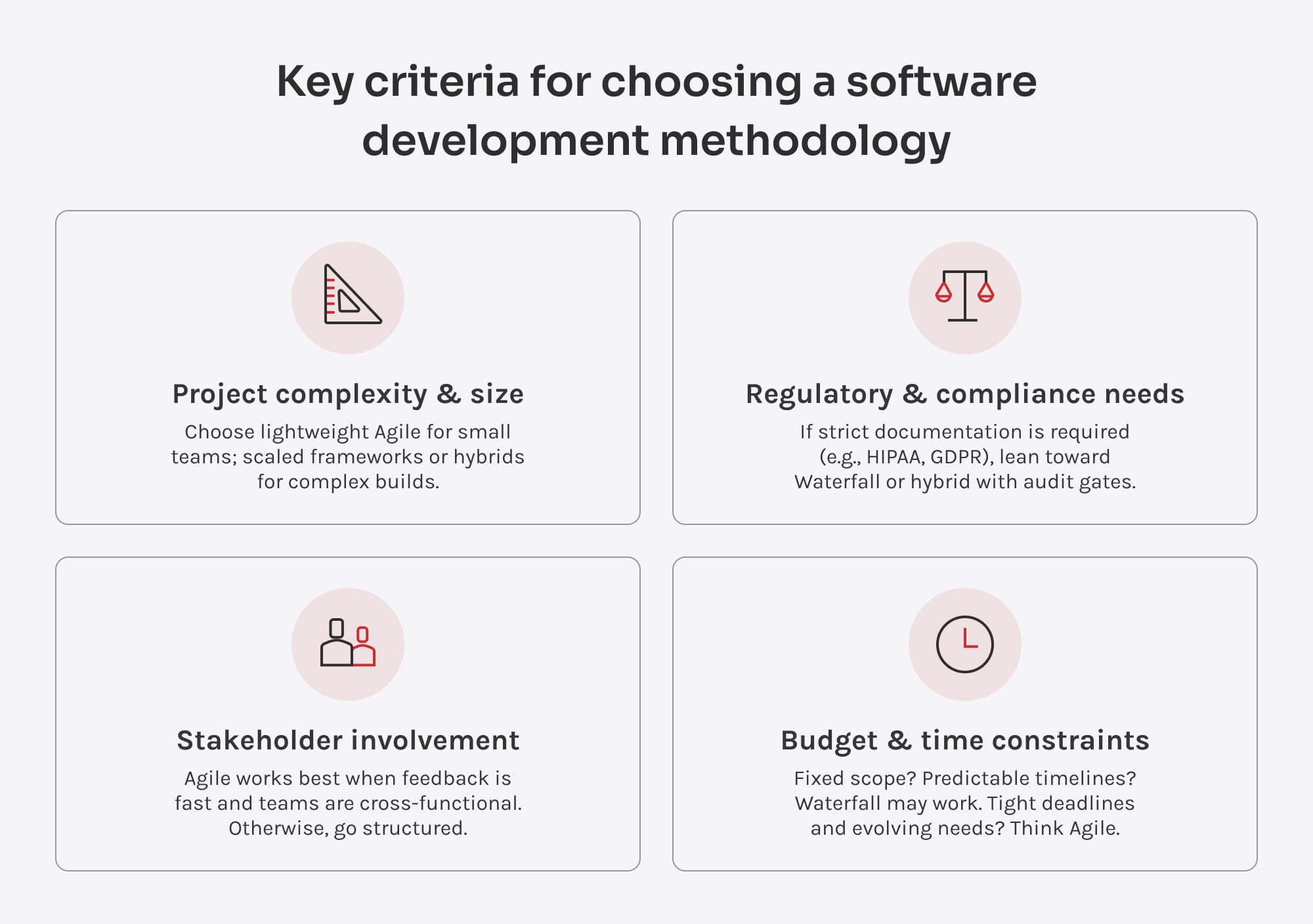
Let’s start with the obvious. A simple internal app for a small team doesn’t need the same software development process methodologies as a national banking platform with multi-region deployments and audit trails.
Small, low-risk projects? Go for lighter-weight Agile frameworks like Kanban or even a Scrum-lite model.
Complex, multi-team, or multi-year builds? You may need a hybrid model or a scaled Agile framework (e.g., SAFe, LeSS) to keep everything aligned.
Tip: Don’t overcomplicate. Use the lightest process that still gives you clarity and control.
Is your software subject to industry regulations (HIPAA, GDPR, ISO, etc.)? If so, you can’t afford process gaps. In such cases, common methods of software development, like Waterfall, can help provide the paper trail and approvals that auditors love.
That said, we’ve successfully combined Agile sprints with compliance gates at major milestones. So if someone tells you “Agile doesn’t work in regulated industries,” they’re either being lazy or too cautious.
Tip: Look for ways to balance agility with traceability.
Some clients want to be deeply involved in the process. Others just want a working product delivered on time. The choice of methodology should reflect that.
High engagement? Scrum is a great application development methodology — it gives stakeholders visibility and influence throughout the cycle.
Low involvement or distributed decision-making? You might want to lean toward Kanban or structured hybrid models that allow asynchronous progress.
Team expertise matters too. You can’t fake Agile maturity. If your developers aren’t used to estimating in story points, running retros, or working in cross-functional squads, forcing a Scrum workflow will backfire.
Tip: Match methodology to both stakeholder behavior and team readiness.
This is the one most people overlook. Agile can help you build just enough, test with real users, and pivot if needed. But it’s not great for clients demanding fixed scope, fixed time, and fixed cost. In that case, Waterfall — or at least a hybrid model with very tight scope control — might make more sense.
Often, agile projects “fail” simply because no one communicated that the scope would evolve, and stakeholders felt blindsided when estimates changed. So yeah, software engineering methods mismatch doesn’t just cause delivery issues. It can erode trust.
Tip: Be honest about flexibility and risk tolerance. Choose accordingly. And if you’re working with an external partner, make sure their process aligns with your goals. A solid outsourcing software development service should help you define the right methodology — not just follow a preset playbook.
Let me paint a quick picture. A few years ago, a client insisted on a full Scrum setup for what was essentially a one-off reporting tool with fixed specs. Daily standups, sprint planning, burndown charts — the whole thing. The dev team spent more time updating Jira than writing code. The project ran over budget because it was too process-heavy.
On the flip side, I once inherited a chaotic app build that had zero structure. The team was making changes in production (yes, really). After switching to a Kanban + DevOps model with clearer workflows and automated testing, we stabilized and launched in under two months.
Tip: The cost of the wrong methodology isn’t just money — it’s missed deadlines, burnout, and broken expectations.
Pro tip: Methodology ≠ religion. Don’t get dogmatic. Methodologies of software development are tools, not belief systems. At Innowise, we always start with business goals first — then choose the methodology or mix of software development practices that helps get us there the fastest, safest, and most cost-effectively.
Let’s be honest: Most teams don’t follow a “pure” methodology anymore. And that’s not a bug — it’s a feature.
What I’m seeing more and more (and what we do ourselves at Innowise) is an evolution from rigid software development frameworks to adaptive systems. Teams take what works — from Agile, Lean, DevOps — and remix it. But they don’t stop there. New trends are emerging that rethink not just how we build software, but how we think about building it in the first place.
If you still think AI in software development is just about writing code faster, you’re missing the bigger picture.
Modern AI tools are changing how we plan, test, refactor, and even design software architecture. Tools like GitHub Copilot, Tabnine, and Amazon CodeWhisperer are becoming part of the team, taking care of boilerplate, suggesting optimizations, and catching errors early. But it’s not just developers who benefit. Product managers and testers are now using AI to auto-generate test cases, user stories, and even UI mockups.
What does this mean for methodologies? Well, if your process isn’t flexible enough to integrate these capabilities, you’re artificially slowing yourself down. Some teams automate entire release validation cycles and cut regression testing time by 70% — just by redesigning their workflows to include AI as a first-class player.
Bottom line: AI-assisted methodologies shift the focus from “doing the work” to “orchestrating the work.” And the teams that embrace this early? They move faster, learn faster, and win faster.
Yes, I mentioned Lean earlier. But the way it’s being used now? That deserves a second look.
Today’s Lean isn’t just about optimizing dev tasks — it’s about aligning every team in the company around measurable customer value. We’re talking Lean Portfolio Management, value-based OKRs, and end-to-end flow metrics across dev, design, marketing, even legal. I’ve worked with enterprise clients applying Lean principles to triage roadmap priorities based on real user behavior — not internal politics.
In other words, Lean has grown up. It’s no longer just a dev thing but rather a company-wide operating model.
Competitive edge: When used at scale, Lean becomes a force multiplier. It makes sure the features you build are not only efficient to deliver but actually matter to your users.
Ever launched a sprint on Monday and wondered by Thursday where all the momentum went? Enter value stream mapping (VSM) — a technique borrowed from manufacturing that’s quietly transforming the way we look at the software delivery process.
Instead of obsessing over velocity or burndown charts, VSM helps teams visualize every step of the product flow, from idea to release. The output? A map of delays, handoffs, rework loops, and approval blockers — basically, all the things that metrics alone won’t show you.
We’ve used VSM in client onboarding workshops to surface friction points before they became project risks. In one case, just mapping the approval chain shaved off two weeks per release cycle. No new tools. No new hires. Just visibility.
Takeaway: VSM turns invisible waste into actionable insight. It’s not flashy — but it’s game-changing.
If there’s one trend that ties all of this together, it’s this: methodologies are no longer fixed paths — they’re customizable toolkits.
At Innowise, we sometimes apply a methodology out of the box. But more often, we build what I like to call “situational playbooks.” For one client, that looked like Scrum sprints powered by AI-generated testing scripts. For another, it was a Lean-DevOps hybrid with continuous delivery pipelines and value stream reviews baked into quarterly planning.
And no, that’s not chaos. That’s maturity.
What does this mean for you? If you’re still picking methodologies like you’re ordering off a fixed menu — stop. Start thinking à la carte. Pick the practices that support your goals, and drop the rest. The only “wrong” methodology in 2025 is the one that refuses to adapt.
Let’s cut through the theory for a minute.
It’s easy to talk about Agile vs. Waterfall vs. DevOps in the abstract — but what does success actually look like when these methodologies hit the real world? I want to share a few stories from projects we’ve led at Innowise, because nothing drives the point home like real outcomes.
We partnered with a US-based IT company to build a custom SaaS platform for IoT device management — a solution that now supports 100% automation of digital device lifecycles using Web 4.0 tech. The idea was bold: a fully scalable cloud app that could manage millions of devices across AWS, Azure, and GCP — with zero manual intervention.
Now here’s the catch. To meet this level of complexity and ongoing feature expansion, we adopted Scrum. The project kicked off in 2021 and ran through the full SDLC stages, incorporating key Scrum events like sprint planning, daily standups, sprint reviews, and retrospectives. We maintained clear visibility and collaboration through tools like Jira and Confluence — but these were just enablers, not the essence of our approach. And no, we didn’t just follow Scrum for the sake of it — we needed flexibility, transparency, and a rhythm that let the team iterate fast and adapt to feedback mid-sprint.
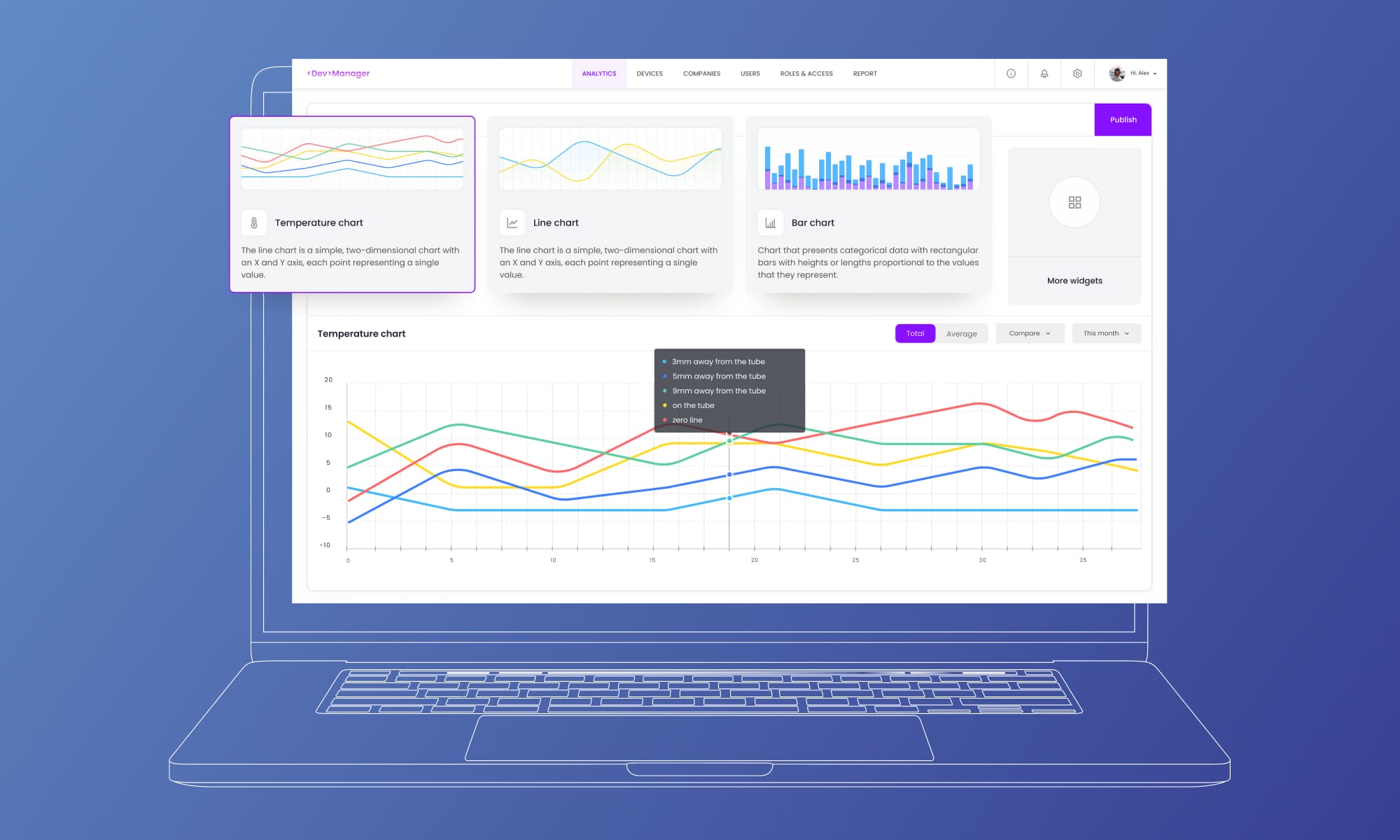
The result? An enterprise-ready microservices platform built from scratch — deployed on cloud or on-premise — with robust role management, MQTT messaging, Grafana-based dashboards, and scalable architecture.
Lesson: The right methodology doesn’t slow you down — it frees you to move fast with direction.
Waterfall gets a bad rap — but when it fits, it fits.
We worked with a major US-based MedTech provider on a custom EHR system that could integrate patient records, billing, telehealth, and lab results — all while meeting HIPAA, GDPR, and security standards.
Here, Agile wasn’t the answer. With multiple stakeholders, fixed feature requirements, and tight regulatory oversight, we stuck to a structured Waterfall approach for the main product development — from discovery to post-launch support. Each phase was clearly scoped, documented, and signed off. The project ran for 17 months and included detailed planning, milestone approvals, and rigorous testing to meet HIPAA, GDPR, and other compliance standards.
Once the core system went live, we transitioned to a more Agile approach for post-launch enhancements. This allowed us to gather feedback from clinicians and iterate on specific modules without disrupting the stability of the released product — blending the initial predictability of Waterfall with the flexibility needed for continuous improvement.
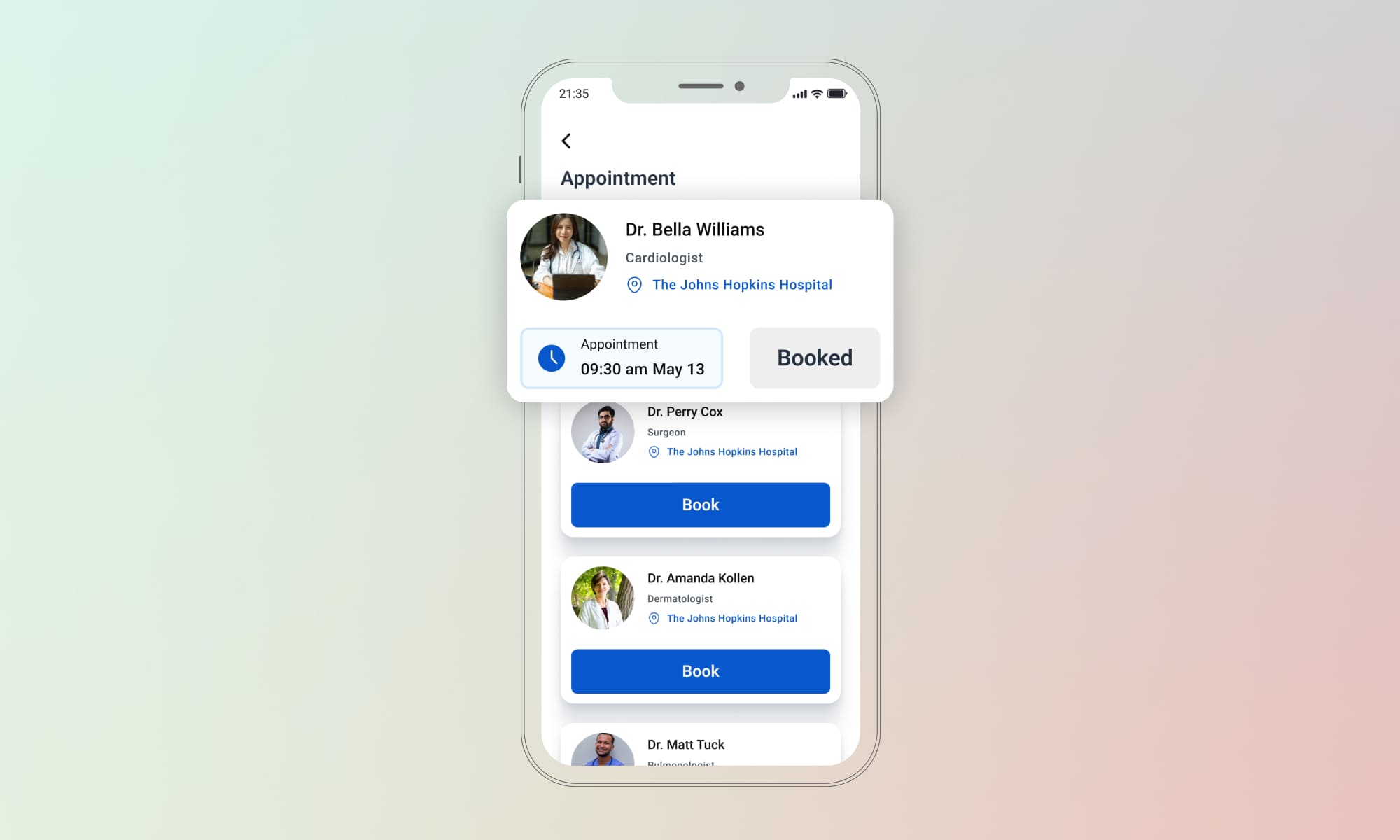
And it paid off. After rollout, clinics saw a 36% reduction in administrative workload and a 16% increase in average daily patient appointments. Staff could focus more on patients, less on paperwork.
Lesson: In high-stakes, highly regulated environments, Waterfall can be your best friend—as long as you execute it with discipline (and leave room for smart adjustments).
This one’s a personal favorite.
A global logistics leader asked us to help with one thing: faster, greener deliveries. What they actually needed was a deep process redesign. Their manual routing system was driving up emissions, causing delays, and racking up costs.
We implemented a Lean + DevOps hybrid. Lean helped us identify waste in the delivery pipeline, while DevOps gave us the automation and continuous deployment muscle to act on it. On top of that, we built a real-time AI-driven platform with smart routing, predictive analytics, and ESG tracking.
Now, here’s a nuance worth noting: the development itself followed a phased Waterfall model, which worked well for planning and sign-offs. But the product’s architecture and delivery mechanisms are deeply DevOps-native — designed for continuous improvement, real-time decision-making, and ongoing machine learning enhancements.
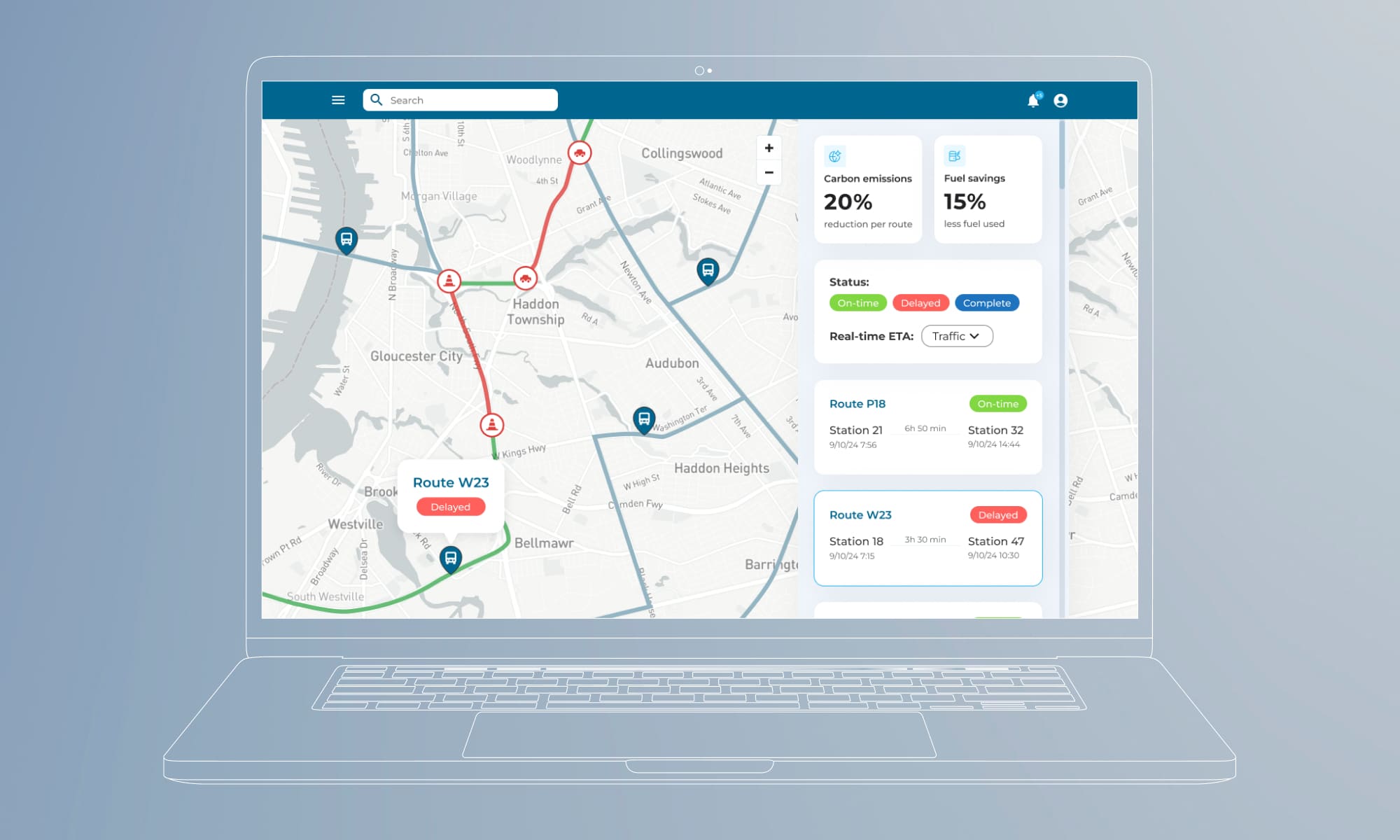
The results were massive:
The methodology supported both technical agility and operational scale — exactly what the client needed.
Lesson: Sometimes the real solution isn’t just “working faster” — it’s rethinking the entire system that slows you down.
If you’re in a leadership role, here’s the hard truth: the methodology your team follows isn’t just “an internal thing.” It directly impacts your bottom line, your delivery timelines, your product quality, and your reputation.
So, before you greenlight the next big project or bring in a vendor, run through this executive checklist. It’s not exhaustive, but it will save you from 6-figure regrets and year-long delays.
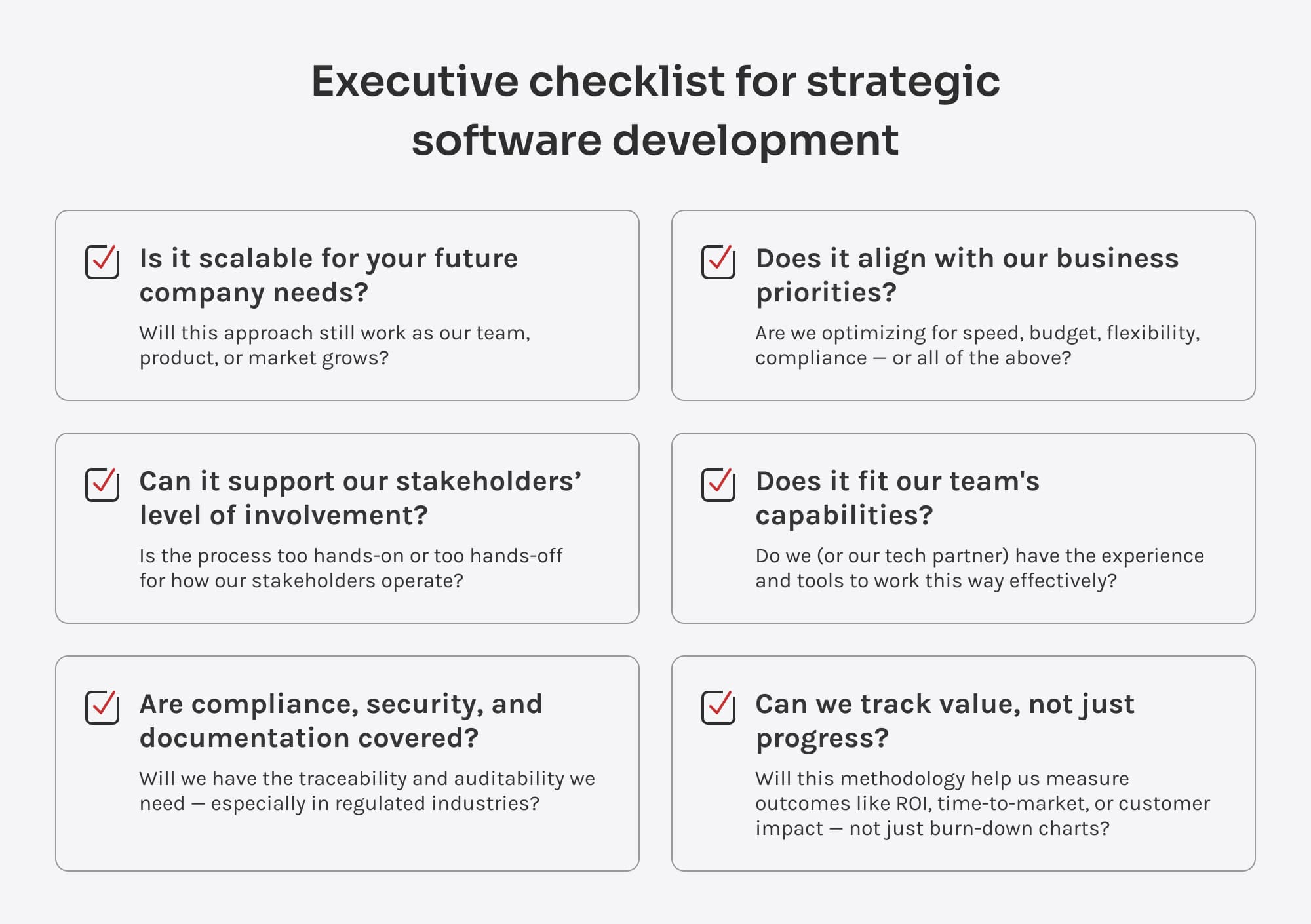
Maybe you’re building an MVP now, but what happens when you hit traction? Can your current approach handle more features, more users, and more compliance needs?
Scrum works great for small, fast-moving teams. But if you’re planning to scale across departments or regions, consider frameworks like SAFe — or at least start thinking about how today’s workflows can evolve later.
Quick tip: Don’t let short-term convenience become long-term technical debt.
I’ve seen startups build incredible platforms, only to stall for months when they hit compliance walls — HIPAA, SOC 2, ISO 27001, you name it.
If you’re in a regulated industry, your methodology must include clear documentation practices, traceable approvals, and security testing baked into the pipeline — not bolted on as an afterthought.
Ask yourself: “If an auditor showed up tomorrow, could we explain our process — and prove it?”
You don’t want your CMO or customer success lead reviewing mockups for the first time in week 12. Your methodology should create regular checkpoints where stakeholders can weigh in, not derail things.
Agile models like Scrum make this easier with sprint reviews and demos. Waterfall? You’d better lock down input early, because changes later will cost you — big time.
Bottom line: Visibility isn’t just a team benefit. It’s a leadership imperative.
Some teams add so many ceremonies, tools, and approval layers that they forget the goal is shipping software. Others operate like a garage startup long after they’ve grown out of it.
If your standups feel like status meetings, or your Jira board looks like a graveyard, it’s time to recalibrate. You don’t need “more Agile.” You need smarter structure.
Executive red flag: If you can’t clearly explain your software development life cycle in under 60 seconds, it’s probably too complicated.
DevOps isn’t just about automation — it’s about alignment. Same goes for Lean. If your business units are lobbing requests over the wall to tech teams, expect delays, friction, and mismatched expectations.
High-performing organizations design their methodology around collaboration, not silos. That might mean cross-functional squads, shared KPIs, or value stream reviews.
Sanity check: Can your product, marketing, and engineering leads sit down and all articulate how work gets prioritized and shipped?
You’d be surprised how many teams are busy ticking off tasks without delivering real value. That’s how you end up with polished UIs and broken customer journeys.
Methodologies like Lean, or even a good Scrum implementation, keep the focus on outcomes — not output.
What to look for: Is your team measuring delivery speed or customer impact? Because if it’s just the former, you’re probably tracking the wrong success metrics.
“The real secret to choosing the right methodology? It’s not about trends — it’s about truth. You have to be brutally honest about your team’s strengths, your constraints, and your goals. Every framework works great on paper. The hard part is making it work for you.”

Global Development Director
The right methodology isn’t just a technical decision — it’s a strategic asset.
At Innowise, we’ve seen firsthand how a well-matched process can speed up delivery, lower risk, and create happier teams and users. And we’ve also seen what happens when companies underestimate their importance. It’s not pretty.
So if you’re planning your next big build, don’t just ask, “What are we building?” Ask, “How are we going to build it — and why that way?”
And if that question is still fuzzy, let’s talk. Helping companies find the right software development approach isn’t just something we do. It’s something we’ve mastered.
Dmitry leads the tech strategy behind custom solutions that actually work for clients — now and as they grow. He bridges big-picture vision with hands-on execution, making sure every build is smart, scalable, and aligned with the business.












Your message has been sent.
We’ll process your request and contact you back as soon as possible.

By signing up you agree to our Privacy Policy, including the use of cookies and transfer of your personal information.